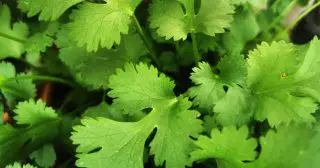Growing cilantro indoors can be just as successful and tasty as growing cilantro in the garden if you pay a little more attention to the plant. If you are going to grow cilantro indoors, please do not transplant plants from the garden. Cilantro does not transplant well.
When growing cilantro indoors, start with seeds or young plants. Make sure the plants are spaced 7.5 to 10 inches apart.
Tips for growing cilantro indoors.
It is best to use an unglazed terra cotta pot when growing cilantro indoors, as it allows more moisture and air to pass through to the roots. Make sure the bottom of the container has enough drainage holes.
Cilantro grown indoors needs more nutrients because the root system has a limited reach and cannot absorb as many nutrients from the soil as it can in the garden. When planting cilantro indoors, the soil should be a mixture of potting soil and sand to allow water to flow freely.
In addition, you can use a fertilizer of liquid fish emulsion or NPK fertilizer 20-20-20 to add additional nutrients.
Use the supplemental fertilizer every two weeks during active growing periods.
Thorough watering is more important than frequent watering when growing cilantro indoors. Water the plants until the water comes out of the drainage holes.
Also check the soil frequently – cilantro grown indoors should only be watered when the soil feels dry. This is more often the case during the summer months.
For healthy indoor coriander growth, it is important that the plant have four to five hours of full sun per day. If you use supplemental grow light, growing cilantro indoors will be even more successful.
When growing cilantro indoors, it is important that you harvest it carefully. Indoor herbs naturally strive for the light, so they can become spindly.
Cut the young green cilantro leaves off at the tips to create a bushier plant. When planting cilantro indoors, keep in mind that it will grow less lush than outdoors in the garden.
However, if the combination of sun exposure, soil mix, moisture and gentle harvesting is right, you will be rewarded with this flavorful and aromatic herb all year round.
Seeds and leaves equally delicious
You harvest the tender, incised leaves of coriander continuously throughout the season until mid-September. They lose flavor when the cilantro begins to flower.
Quick Tip:
- If your interest is primarily in the leaves, you can plant it in the shade and it will come into bloom later. Cut off the umbels before the dainty white flowers appear, so the cilantro doesn’t put its energy into the seeds.
- If you prefer the spherical, sweet-spicy coriander seeds, you can ideally harvest them just before they are fully ripe in August or September. Cut them off near the ground and hang them in bunches of three to five stems in a warm, dry place where they can ripen.
- When they are completely brown and dry, they acquire their characteristic fine spicy sweet aroma. Now the round, fluted globules can be detached from the cones.
- Coriander seeds will keep for several years in screw-top jars, provided they are truly dried through.
I hope that I could give you a little insight into the cultivation and care of this versatile and especially in the kitchen indispensable spice plant. I wish you much fun with the cultivation and harvest.










